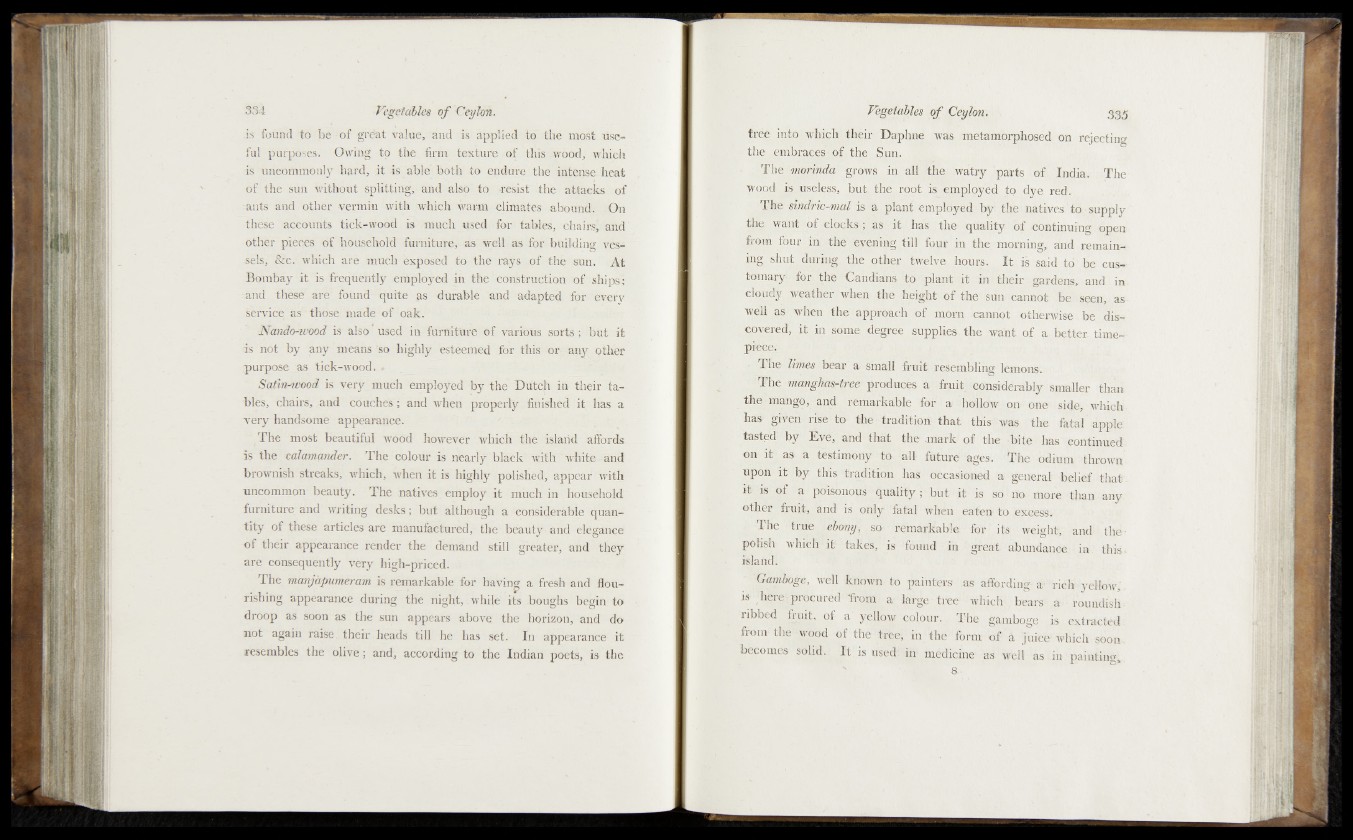
is found "to be of gréât value, and is applied to the most useful
purposes. Owing to the firm texture of this wood, which
is uncommonly hard, it is able both to endure the intense heat
of the sun without splitting, and also to resist the attacks of
ante and other vermin with which warm climates abound. On
•these accounts tick-wood is much used for tables, chairs, and
other pieces of household furniture, as well as for building vessels,
-&c. which are much exposed to the rays of the sun. At
Bombay it is frequently: employed in the construction of ships;
--and these1 arc found quite as durable and adapted, for ■e-verv
service as those made of oak.
Nando-iuood is also used in furniture of various sorts ; but it
as not by any means so highly esteemed for this 01 any other
•purpose Jas tiek-wood. .
Satin-wood is very much employed by the Dutch in their tables,
chairs, -and couches ; and when properly finished it has a
“very handsome appearance.
The most beautiful wood however which the island affords
is the calamander. The colour is nearly black with white and
brownish streaks, which, when it is highly polished, appear with
uncommon beauty. The natives employ it much in household
furniture and writing desks ; but although a considerable quantity
of these articles are manufactured, the beauty and elegance'
of their appearance render the demand still greater, and they
are consequently very high-priced. •
The manjàpumeram is remarkable for having a fresh and flourishing
appearance during the night, .while its boughs begin, to
droop as soon as the sun appears above, the horizon, and do
not again raise, their heads till he has set. In appearance it
resembles the olive; and, according to the Indian poets, is the
tree into^wMghjjth^ir' Daphn§, was metamorphosed on rejecting
the, ■.^b.rk^ajBpKfe^im. 1
The méfmda :gn^&4i|| all the watry 'pgfrts of India. The-
wood j^ n sele'i^ but, .the root isjgmrfoyed to dye red.
The sindric-mal is a plant employed by the natives' to supply
the want it has "the«^quality ,ctf Continuing open
from four®»'4hê"^yehi|g tilK f o p r ^ the.morning, and remains
ing. shut during the other twelve hours. I t is said to be customary
for the Candians to plant it in their gardens, and in.
doildy weather when the height of the sun cannot be seen, as-
wdi as -when f t è ^ p p ro a c h -©J^mor n .Cannot -otherwise be discovered",
i l ifefec^q^degre1e supplies- the want of 'a better time-
pieèöci _ f-'
' feeaF a shiall fruit resembling lemons1.,
■ 'The ■mangfïasrtree' produces as , fruitptohsiddrably smaller than
tho mahgd, and remarkable fob-a hollow on” onfe-fside, which,
has^ gfven rise to th é ; tradition that this was < the fatal apple
tasted1 by Eve, and that the mark- of the b ite has continued
on* i t as a testimony do all1 fttu re ‘ages. '-The odium thrown
npdii- it by this tradition has occasioned a- general belief that-
5t is of a poisonous quality; but it is so no more than any.-
other fruit, and is only fatal when eaten to excess.
The ■ true ebony, so remarkable, for its- weight, and thé-
polish which it takes;.: is found in great abundance in . this ,
island
Gamboge, well known to painters as affording a- richiyillow,"
is diere procured from a large tree which , bears- a- - roundish;
ribbed fruit, of a yellow colour.. The gamboge is extracted,
from the wood of the tree, in the form of a - juice-which soon,
becomes solid. I t is used in medicine as well as in painting*.,